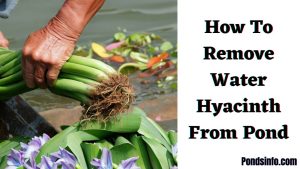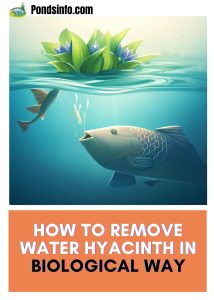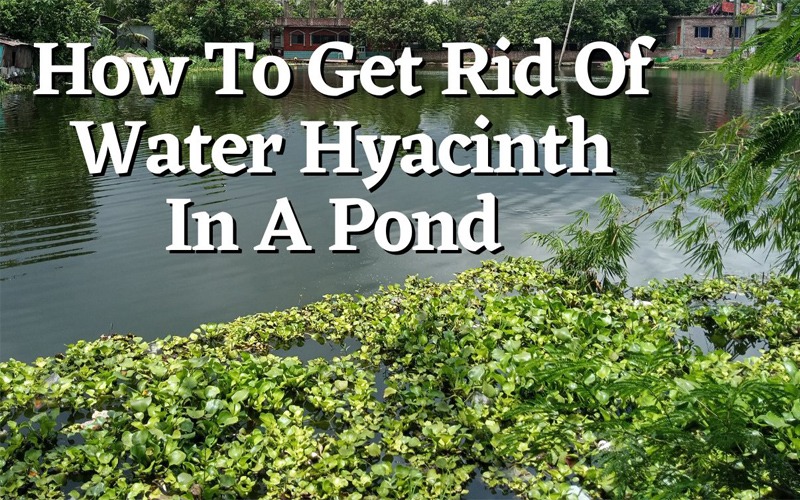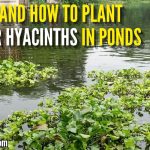Water hyacinth is an aquatic plant that is massively found in South America, South Asia, and Africa. Also, this aquatic plant is found in some parts of North America. Although water hyacinths have some essential benefits if they are little in quantity, they can also create a negative impact on the pond ecosystem, if they are massive in quantity.
Water hyacinth can cause problems such as ecological disruption, water quality degradation, reduced biodiversity, obstructed water flow and navigation, increased mosquito breeding, and overall economic losses (if you are a fish farmer).
Since water hyacinths grow and spread so fast, you should control their growth and if needed, you should remove water hyacinths from ponds, to balance the ecosystem and ensure safety for other aquatic plants and animals.
So how to get rid of water hyacinths in a pond? Okay, don’t worry if your pond is full of water hyacinth. Because today we will tell you 5 different and easiest methods to remove water hyacinths from ponds, whether it is a small or big pond.
How To Remove Water Hyacinth From Pond

Removing water hyacinth is not too hard if you know the right process. And considering your different weather, location, and pond size, here we are going to share 5 different and easiest methods of removing water hyacinths from ponds. Here are these 5 methods:
- Remove Water Hyacinth Manually
- Remove Water Hyacinth By Cutting and Harvesting
- Remove And Control Water Hyacinth In Biological Way
- Remove Water Hyacinth Controlling Water Nutrient
- Use Herbicides Or Chemicals To Remove Water Hyacinth
Below, we will describe every method, so keep reading and find out which one is helpful for you.
How To To Get Rid Of Water Hyacinth Manually
The easiest and most effective way to remove water hyacinths from a pond is to use manual techniques. So let’s see how you can remove water hyacinth manually.
1. Gather Tools
First of all, you need to gather the necessary tools. To remove water hyacinth manually you need tools such as a rake, net, or long-handled cutting tool.
2. Wear Protective Gears
Now wear safety gears which is needed, you can wear a good pair of gloves and appropriate protective clothing. If the weather is cold wear warm cloth. Protective gear can help your skin from irritation or any potential allergies.
3. Start From The Edges
To remove water hyacinths manually from a pond in a short time, start to remove them from the edges of the pond. Additionally, work your way toward the center. This will help you prevent the spread of fragments and seeds while making the removal process more manageable.
4. Use A Rake Or Net
You should use a rake or net to gather the plants if the water hyacinth is relatively dense. Scoop water hyacinth as much as possible by dragging the rake or net through the water. Then collect the plants into a pile or on a boat or a separate space.
5. Pull Out The Plants
If it is hard to collect water hyacinths using a net because of their highly densely packed then manually pull out them by hand. Grab the water hyacinths firmly at the base and pull them out, stay careful from harmful pond animals like snakes.
6. Dispose Of The Removed Plants
When you have collected all the water hyacinths, dispose of them properly. Dispose of these plants away from the pond and water sources and make sure that they can’t reach the pond again.
7. Repeat The Process Often
Once you cleared the whole pond don’t think your duty is over. You have to do it regularly. If you can do it regularly then your pond will be water hyacinth free, or you may control their growth.
On the other hand water hyacinth can grow rapidly, so if you don’t repeat this process often then your pond will turn into a water hyacinth mess within a few days.
But if you want to balance the pond ecosystem you should keep a little amount of water hyacinth in your pond. Although water hyacinths have both advantages and disadvantages, if they are in a little quantity then you don’t need to worry.
How To Get Rid Of Water Hyacinth By Cutting
This is another type of manual process to remove water hyacinth from the water. And here we will describe step by step how you can remove water hyacinths from a pond by cutting them.
Step 1: Gather Tools And Put Safety Wear
For cutting you need some essential cutting tools like a sharp knife, scissors, or a sickle. So, first of all, collect them and make sure the tools are in good condition for effective cutting.
And then put safety wear, like a good pair of gloves and other safety wear, since you will work with a sharp knife or scissors.
Step 2: Choose A Starting Point
Based on the growth and density select a point in your pond where the plants are most concentrated. And then start cutting from there.
Step 3: Cut At The Base
In this step, you should start cutting using the tool that you choose. For a better result cut the water hyacinth at the base, just above the water surface. Cutting at the base disrupts the growth of the plants and make slows their ability to reproduce.
Step 4: Remove The Cut Vegetation And Dispose
After cutting them properly, collect the cut vegetation from the water. To collect them you can use a rake, net, or other suitable tools to gather them.
Then take them far away from the pond and dispose of the water hyacinth properly. Remember, don’t leave any way to come back the water hyacinth again in the pond.
You can repeat the cutting process often if they again came back to the pond. Additionally, cutting water hyacinths often from the pond is a good way to control water hyacinths.
How To Remove Water Hyacinth In The Biological Way

Biological control of water hyacinth is so effective and becoming popular day by day. Here we will share the proper process of removing water hyacinth biologically.
1. Identify Suitable Biological Control Agents:
Research and identify natural predators which can feed water hyacinth. For example, you can use some specific insects like weevils or moths.
On the other hand, you can use certain fish species, like grass carp which can eat water hyacinth. These types of insects and fishes can control and reduce the growth of water hyacinths.
And, in the long term, they can give you the best result compared to other ways. But before introducing grass carp in your pond you need to know how many grass carp do you need for your pond.
2. Obtain And Introduce The Biological Agents
Before introducing biological agents in your pond you should follow regulations or permits that are essential and you should maintain. Suppose, if you want to introduce grass carp, first you need to know whether grass carp fishes are good or bad for ponds.
3. Introduce The Agents Properly
When the benefits and disadvantages of biological agents are clear to you introduce them properly with your pond. You can follow the instructions provided by the supplier or experts.
4. Monitor And Evaluate The Results
Once you introduce biological agents you should monitor them regularly, and also monitor the density of water hyacinth. Try to observe the impact on the water hyacinth plants and assess whether the infestation is being suppressed or reduced over time.
5. Consider Long-Term Maintenance
Remember, biological control methods may require a long time, but they give the best outputs. The long-term management plan includes regular inspections, population assessments, and necessary adjustments to sustain the control of water hyacinths.
That’s the way how you can remove water hyacinth from your pond using biological methods.
How To Remove Water Hyacinth Controlling Water Nutrients
We have already told you how to get rid of water hyacinths in a pond using several different methods. Now, here we are going to describe another effective way to reduce the growth of water hyacinths. You can remove water hyacinths from your pond by controlling water nutrient levels.
By implementing proper nutrient management strategies, you can control the growth of water hyacinths. Here are some steps for removing water hyacinths by controlling water nutrients.
Step 1: Test Water Nutrient Levels
First of all, you should test the water nutrient levels from your pond, more specifically nitrogen and phosphorus. This test will help you to understand the current nutrient status of your pond.
Step 2: Minimize External Nutrient Inputs
Once you tasted it, try to identify and minimize the sources of nutrient inputs to the pond. This process includes reducing the use of fertilizers, managing runoff from surrounding areas, and limiting the discharge of wastewater.
Sometimes, rainwater can contain nutrients from those lands which are near your pond. Not only nutrient but there are also lots of changes that happen when its rain in a pond.
Step 3: Buffer Zones And Vegetative Barriers
You can establish buffer zones or vegetative barriers around the pond, which can act as natural filters. In addition, this zone will trap and absorb nutrients before they enter the water. You can plant grasses, shrubs, or trees around the pond which can help reduce nutrient runoff.
Step 4: Algae Management
You will be surprised to hear that, proper algae management techniques, such as nutrient limitation or the use of algaecides, can help reduce nutrient availability for water hyacinth.
Step 5: Regular Monitoring And Adjustment
If you choose this process to remove water hyacinth from the pond you should monitor water quality regularly. Especially, monitor water quality parameters, including nutrient levels. If necessary adjust the nutrient management strategies.
How To Remove Water Hyacinth Using Chemicals
Nowadays, we can see that many of us remove water hyacinths using chemicals. It’s effective, but it can harm other water plants and animals. However, before using chemicals know the local regulations properly. Let’s see how you can remove water hyacinths using chemicals.
1. Identify The Appropriate Herbicide
First of all, consult with aquatic specialists or professionals to determine the most suitable herbicide or chemicals for water hyacinth. Different herbicides have varying effectiveness and application methods, so make sure that you are choosing the right one.
2. Read And Follow The Instructions
You are using chemicals, so it’s necessary to read all the instructions, precautions, and dosage rates carefully that are provided by the manufacturer. If needed, wear safety equipment.
3. Choose The Right Time For Treatment
For removing water hyacinth, timing is important for chemicals or herbicide applications. You should use chemicals when water hyacinth actively growing and before it reaches its maximum coverage.
One thing you should keep in mind is don’t treat chemicals during heavy rainfall is expected.
4. Apply The Herbicide
Now, by following the recommendation apply the chemicals. You can apply chemicals to remove water hyacinth by spraying or using a controlled-release product. Remember, don’t apply chemicals near desirable plants or in areas where they could harm aquatic life.
5. Monitor And Reapply If Necessary
After applying monitor the growth and condition of water hyacinth, if needed reapply the herbicide as recommended by the manufacturer.
6. Dispose Of Herbicide-Treated Plants
Remove and properly dispose of the treated water hyacinth by maintaining local regulations. Also, make sure that water hyacinth does not reenter the water or spread to other areas.
So now it’s clear to you how to get rid of water hyacinths in a pond because we have already shown 5 different methods to remove water hyacinths from small and large ponds. You can follow the suitable one which goes well with your ponds.
If you have more questions about ponds aquatic plants, and aquatic animals then feel free to ask us. We will answer all of your pond-related questions. To get regular updates about ponds stay connected with us and follow us on social media.





